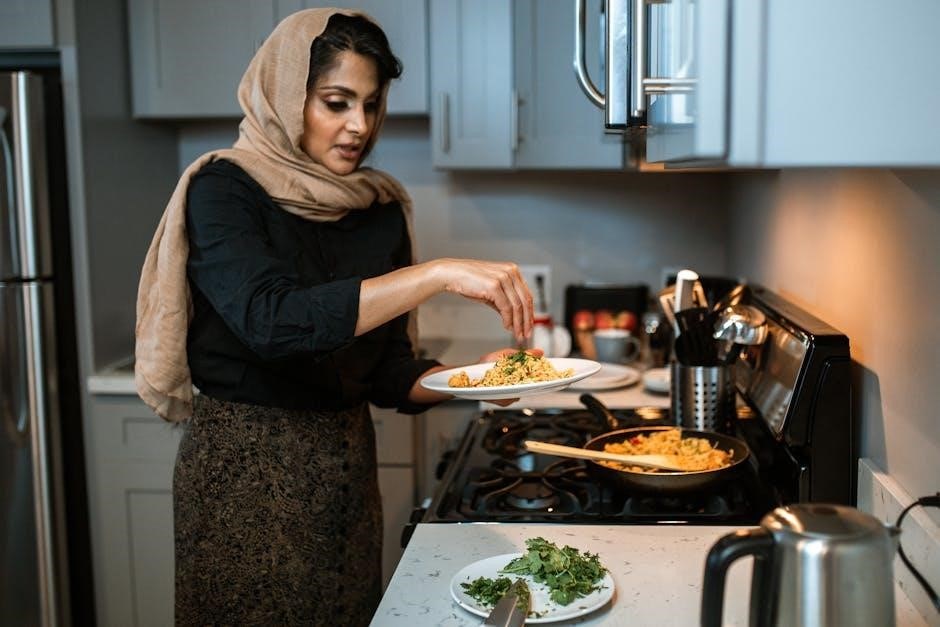Calrose rice is a medium-grain variety known for its versatility and creamy texture. Originating in California, it’s widely used in dishes like sushi and curries due to its stickiness. This rice balances flavor and nutrition, making it a popular choice for both everyday meals and special recipes.
What is Calrose Rice?
Calrose rice is a medium-grain variety developed in California, known for its balanced stickiness and mild flavor. It’s ideal for sushi, curries, and everyday dishes due to its soft texture and ability to hold together without being overly sticky. Grown in the U.S., this rice is versatile and adaptable, making it a popular choice for both traditional and modern recipes.
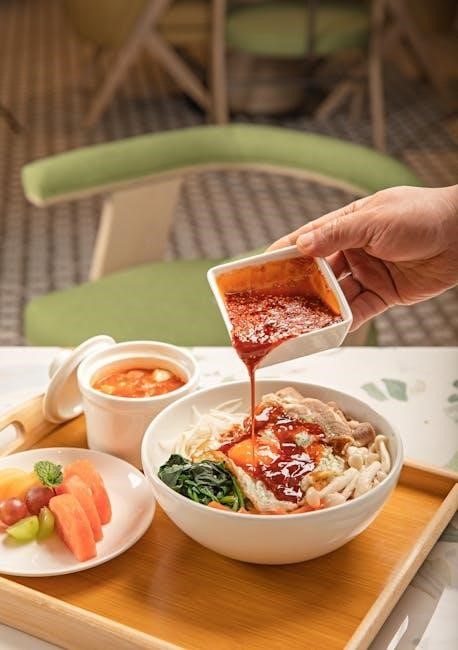
Essential Tools for Cooking Calrose Rice
Essential tools for cooking Calrose rice include a pot, rice cooker, colander, and measuring cups. A pot allows stovetop cooking, while a rice cooker offers convenience.
Pot or Saucepan
A pot or saucepan is a fundamental tool for cooking Calrose rice on the stovetop. Use a medium-sized pot with a lid to ensure even heat distribution. Add rice and water, bring to a boil, then reduce heat to low, cover, and simmer until the water is absorbed. This method allows for precise control over the cooking process, ensuring perfectly cooked rice every time.
Rice Cooker
A rice cooker simplifies the process of cooking Calrose rice. Rinse the rice, add it to the cooker with water and a pinch of salt, then use the white rice setting. This method ensures consistent results with minimal effort. The rice cooker automatically adjusts heat and timing, making it ideal for hands-off preparation and perfectly cooked rice every time.
Colander or Fine-Mesh Strainer
A colander or fine-mesh strainer is essential for rinsing Calrose rice before cooking. Rinsing removes excess starch, reducing stickiness and ensuring fluffy results. Rinse under cold water, swirling the rice with your hands, until the water runs clear. This step is crucial for achieving the desired texture and preventing clumping during cooking. A fine-mesh strainer is ideal for capturing all grains while draining thoroughly.
Measuring Cups
Measuring cups are vital for accurately portioning Calrose rice and water. Use a 1:1.25 to 1:1.5 water-to-rice ratio for optimal texture. Measuring ensures consistency, preventing undercooked or mushy results. Dry and liquid cups may differ, so dedicated rice measuring tools or standard cups are recommended. Accurate measurements are key to achieving fluffy, evenly cooked grains every time, making measuring cups indispensable in the process.
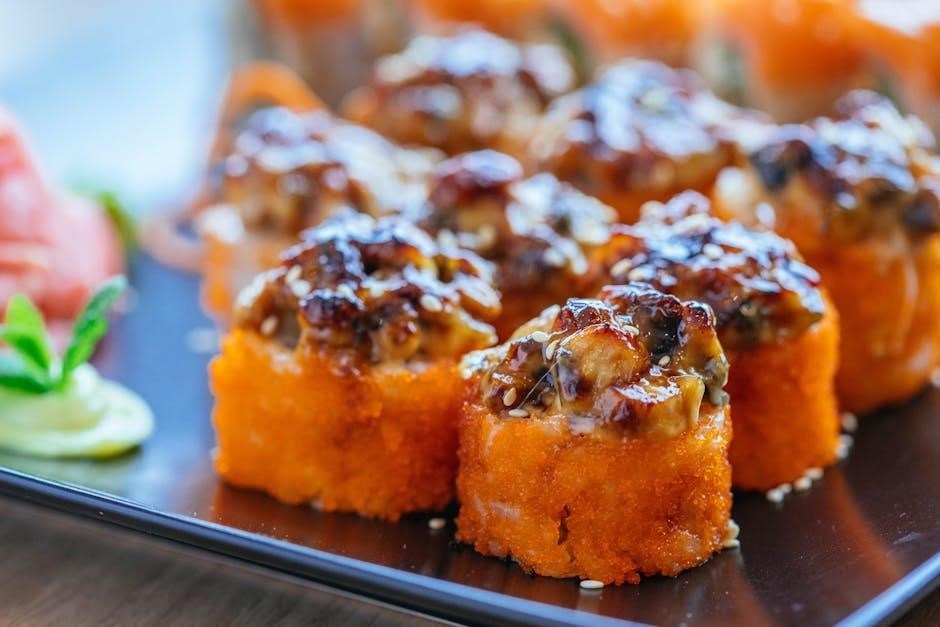
Preparation Steps for Calrose Rice
Preparation involves rinsing the rice to remove excess starch, ensuring a less sticky texture. Optionally, soaking the rice can enhance softness. Accurate water measurement is crucial for ideal consistency.
Rinsing the Rice
Rinsing Calrose rice under cold water removes excess starch, reducing stickiness. Repeat until water runs clear, typically 3-4 rinses. This step ensures grains cook evenly, preventing clumpiness. Proper rinsing enhances texture, resulting in fluffier rice. It’s a simple yet crucial step for perfect cooking. Always rinse thoroughly before cooking for best results.
Soaking the Rice (Optional)
Soaking Calrose rice is optional but can reduce cooking time and ensure tender grains. Rinse rice, then soak in water for 10-15 minutes. After soaking, drain and cook as usual. This step helps rehydrate the rice, making it cook more evenly and prevents excessive starchiness. Soaking is particularly useful for achieving the desired texture in dishes like sushi or curries.
Measuring Rice and Water
Accurate measurement is key for perfect Calrose rice. Use a 1:1.25 to 1:1.5 water-to-rice ratio. For 1 cup of rice, add 1.25–1.5 cups of water. Adjust based on desired texture: less water for firmer grains, more for creamier rice. Ensure measurements are precise to avoid undercooked or mushy results. This ratio ensures balanced hydration and optimal flavor absorption during cooking.
Cooking Methods for Calrose Rice
Calrose rice can be cooked using stovetop or rice cooker methods. Both ensure tender results. The stovetop allows for easy monitoring, while rice cookers offer convenient hands-free cooking.
Stovetop Method
For stovetop cooking, combine 1 cup of rinsed Calrose rice with 1.25–1.5 cups of water in a saucepan. Bring to a boil, reduce heat to low, cover, and simmer for 15–20 minutes. Turn off heat and let rest, covered, for 5 minutes. Fluff gently with a fork for perfectly cooked, fluffy rice. This method ensures even cooking and a tender texture.
Rice Cooker Method
Rinse Calrose rice thoroughly and add to the rice cooker with a 1:1.25 to 1:1.5 water-to-rice ratio. Add a pinch of salt for flavor. Use the white rice setting or adjust according to your cooker’s instructions. Cooking typically takes 15–20 minutes. Once done, let it rest for 5 minutes before fluffing with a fork for perfect, fluffy results every time.

Choosing the Right Water-to-Rice Ratio
The ideal water-to-rice ratio for Calrose rice is 1.25 to 1.5 cups of water per 1 cup of rice, ensuring a tender yet separate grain texture.
Understanding the Ideal Ratio
The ideal water-to-rice ratio for Calrose rice typically ranges from 1.25 to 1.5 cups of water for every 1 cup of rice. This range ensures the rice cooks evenly, with a slightly firm texture at the lower end and a softer, creamier texture at the higher end. The ratio may vary slightly based on humidity and cooking methods, such as stovetop or rice cooker; Adjusting the ratio allows for personalized texture preferences while maintaining optimal cooking results.
Adjusting for Desired Texture
Calrose rice texture can be tailored by adjusting the water ratio. For firmer grains, use 1.25 cups of water per cup of rice, yielding separate, fluffy results. For softer rice, increase to 1.5 cups, creating a creamier texture. This flexibility makes Calrose rice adaptable for dishes from sushi to curries, ensuring the perfect consistency every time, whether you prefer it sticky or light. Adjustments are simple and effective, enhancing overall meal quality with minimal effort, making Calrose rice a versatile choice for various culinary needs.
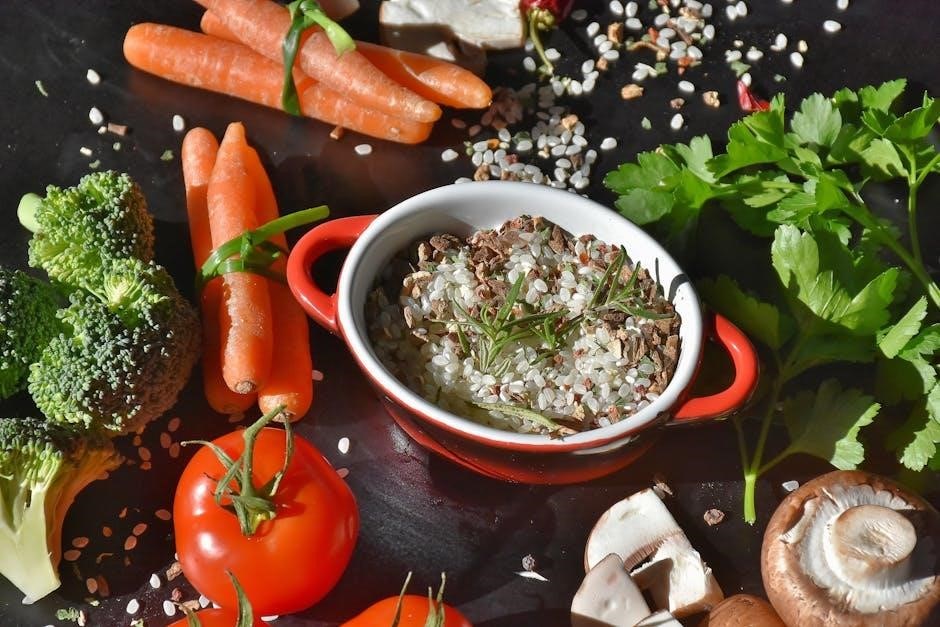
Seasoning Your Calrose Rice
Enhance flavor by adding salt during cooking, or mix in rice vinegar, sugar, and soy sauce for sushi. Herbs and spices can elevate your dish, making it more aromatic and savory, perfect for accompanying various cuisines or standing as a main attraction, ensuring every bite is delicious and memorable with simple yet effective seasoning techniques.
Salt to Enhance Flavor
Adding a pinch of salt during cooking enhances the natural flavor of Calrose rice, ensuring a balanced taste. Salt helps bring out the rice’s inherent sweetness without overpowering it. Use it sparingly to avoid sogginess, as excess salt can disrupt the texture. This simple step elevates the dish, making it a perfect complement to various cuisines, from sushi to hearty meals, with a subtle yet impactful flavor boost.
Optional Additions for Sushi Rice
For sushi rice, enhance Calrose rice with traditional additions like rice vinegar, sugar, and salt. Mix a solution of 1/4 cup rice vinegar, 1 tablespoon sugar, and 1 teaspoon salt for every 3 cups cooked rice. Gently fold into warm rice to balance flavors and textures, ensuring a perfect base for sushi rolls or nigiri, with a tangy and lightly sweetened taste that complements fish and other toppings beautifully.

Common Mistakes to Avoid
- Overcrowding the pot, leading to uneven cooking and mushy texture.
- Not allowing the rice to rest, which prevents grains from separating properly.
Overcrowding the Pot
Overcrowding the pot is a common mistake that leads to uneven cooking and a mushy texture. To avoid this, use a saucepan with enough space for the rice and water to expand. A general rule is to use a pot at least 3-4 quarts in size for every 2 cups of uncooked rice. This ensures proper steam circulation, resulting in perfectly cooked grains. Additionally, overcrowding can cause the rice to stick together, making it difficult to achieve the desired separate and fluffy texture. Always leave enough room in the pot to allow the rice to cook evenly and absorb the water properly. This simple step can make a significant difference in the final result of your Calrose rice dish.
Not Allowing the Rice to Rest
Failing to let the rice rest after cooking can result in a soggy or clumpy texture. Once cooked, turn off the heat and keep the pot covered for 10-15 minutes. This allows steam to distribute evenly, ensuring fluffy and separate grains. Skipping this step can lead to uneven cooking and a less desirable texture, making the rice sticky and unappealing. Resting is essential for perfect results.
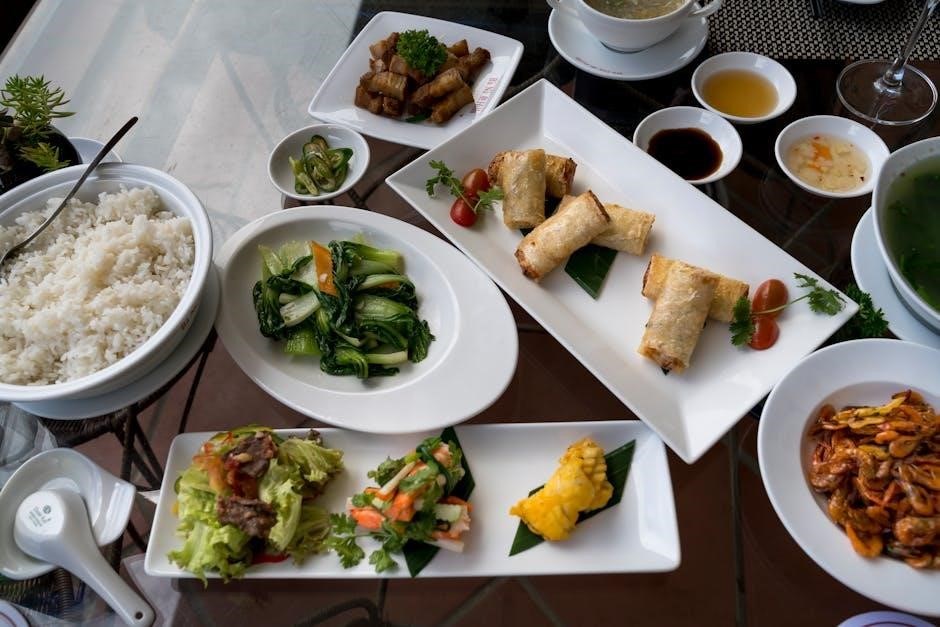
Cooking Time and Resting Period
Cooking Calrose rice typically takes 15-20 minutes stovetop and 10-15 minutes in a rice cooker. After cooking, let it rest covered for 5-10 minutes to ensure fluffiness.
Stovetop Cooking Time
Stovetop cooking for Calrose rice involves combining measured rice and water in a saucepan, bringing to a boil, then reducing heat to low. Cover and simmer for 15-20 minutes until water is absorbed. Avoid lifting the lid during cooking to ensure even steam retention. This method yields fluffy, tender grains with minimal effort and monitoring.
Rice Cooker Cooking Time
Cooking Calrose rice in a rice cooker typically takes 25-30 minutes. Add the measured rice and water (1:1.25 to 1:1.5 ratio) to the cooker. Most models have a white rice setting suitable for Calrose. Once started, the cooker automatically adjusts heat for even cooking. Avoid opening the lid during the process. The result is perfectly cooked, fluffy rice with minimal effort required.
Importance of Resting Time
Resting time is crucial for Calrose rice as it allows steam to distribute evenly, ensuring grains separate and texture becomes fluffy. After cooking, let the rice sit covered for 10 minutes to prevent stickiness and achieve the desired consistency. This step enhances flavor and texture, making it essential for perfect results every time.
Serving Suggestions
Calrose rice pairs perfectly with curries, stews, and gravies, adding a comforting base to meals. It’s also ideal for sushi, rice bowls, or as a side dish, offering versatility in both Asian and Western cuisine.
Pairing with Curries and Gravies
Calrose rice is an excellent base for curries and gravies, as its medium-grain texture absorbs flavors beautifully. It complements both mild and spicy dishes, such as coconut-based curries or rich tomato gravies. The rice’s slightly sticky nature helps it cling to sauce, enhancing the overall flavor experience. This makes it a versatile and delicious addition to any meal.
Using as Sushi Rice
Calrose rice is a preferred choice for sushi due to its stickiness and ability to hold together. Rinse thoroughly, then cook with a 1:1.25 water ratio. Season with rice vinegar, sugar, and salt to enhance flavor. Its mild taste and clingy texture make it ideal for sushi rolls and nigiri, ensuring a traditional Japanese dining experience with every bite.
Incorporating into Rice Bowls
Calrose rice is a versatile base for rice bowls, offering a mild flavor and fluffy texture. Pair it with grilled meats, roasted vegetables, or eggs for a balanced meal. Its slight stickiness helps hold ingredients together, making it ideal for customizable bowls. Season with soy sauce or sesame oil for added flavor, creating a nutritious and satisfying dish that complements a variety of toppings.
